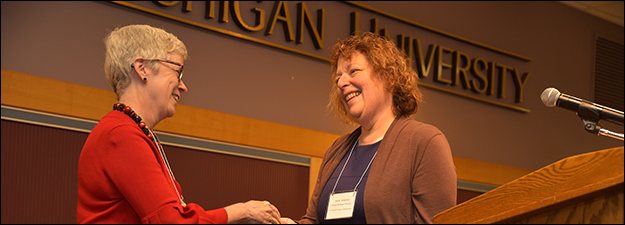Art and Liturgical Performance in Medieval and Early Modern Nunneries
Sponsoring Organization(s)
Société d'Études Interdisciplinaires sur les Femmes au Moyen Âge et à la Renaissance (SEIFMAR)
Organizer Name
Mercedes Pérez Vidal
Organizer Affiliation
Univ. degli Studi di Padova
Presider Name
Fiona J. Griffiths
Presider Affiliation
Stanford Univ.
Paper Title 1
Praying in Catalan Clarissan Monasteries: Books and Regulations on Liturgy and Devotion (Thirteenth-Sixteenth Century)
Presenter 1 Name
Araceli Rosillo-Luque
Presenter 1 Affiliation
Arxiu-Biblioteca dels Franciscans de Catalunya
Paper Title 2
Recovering the Liturgical Books and _Disjecta Membra_ from the Dominican Nunneries Northern Italy
Presenter 2 Name
Mercedes Pérez Vidal
Start Date
13-5-2017 10:00 AM
Session Location
Schneider 1330
Description
Although in the last two decades there has been an efflorescence of monastic studies on female monasticism, partly overcoming the previous lacunae, some issues still deserve further attention.
This is the case of liturgy, a field in which scarce research has been done heretofore, mainly by musicologists, liturgists or art historians specialized in illuminated manuscripts. Furthermore, scholarship to date has been focused on some territories and chronologies, with some notable exceptions that have opened new ways. A third problem has been the lack of a gender approach in this field. However, as a few inspiring studies have pointed out, gender shaped the liturgical practices of women in the same way as other aspects of monastic life. Finally, only few studies have analysed the liturgical performance in relation to monastic spaces, paintings, liturgical objects and furniture, as well as other artifacts.
This session aims to bring together scholars from different disciplinary backgrounds—historians, art historians, musicologists, liturgists— working on liturgical sources coming from nunneries, on liturgical performance, as well as on the functionality of monastic art and architecture.
We will cover a broad chronological span encompassing the Middle Ages and the Early Modern Period, as this will allow us to consider the evolution and changes in liturgical performance and the consequences of all this in art and architecture. We will also cut across monastic orders, taking into account their peculiarities but studying them in the broader context of female monasticism. Finally, we will take into account case studies from different geographical areas (including not only Europe but also Latin America), to boost comparative analysis.
We hope to address the aforementioned gaps in current research in order to :
- Study of the different types of sources regarding liturgy: prescriptive sources (monastic rules, constitutions and regulations from the Orders, etc) and documents of practice (musical codices, visitation records, inventories, letters, etc). By comparing them, we will analyse regional peculiarities, transgressions, etc.
- Analyse of specific liturgical sources: their production meaning, function, whereabouts etc, specially putting them in relation to their monastic and cultural context.
- Highlight the role played by enclosure in the shaping of liturgical and paraliturgical practices inside nunneries.
- On the contrary, draw attention to the definition of a sacral topography through liturgical performance outside the nunneries.
Define the role of images, liturgical objects, books, and other artifacts of material culture, as well as architectural spaces in liturgical performance
Mercedes Pérez Vidal
Art and Liturgical Performance in Medieval and Early Modern Nunneries
Schneider 1330
Although in the last two decades there has been an efflorescence of monastic studies on female monasticism, partly overcoming the previous lacunae, some issues still deserve further attention.
This is the case of liturgy, a field in which scarce research has been done heretofore, mainly by musicologists, liturgists or art historians specialized in illuminated manuscripts. Furthermore, scholarship to date has been focused on some territories and chronologies, with some notable exceptions that have opened new ways. A third problem has been the lack of a gender approach in this field. However, as a few inspiring studies have pointed out, gender shaped the liturgical practices of women in the same way as other aspects of monastic life. Finally, only few studies have analysed the liturgical performance in relation to monastic spaces, paintings, liturgical objects and furniture, as well as other artifacts.
This session aims to bring together scholars from different disciplinary backgrounds—historians, art historians, musicologists, liturgists— working on liturgical sources coming from nunneries, on liturgical performance, as well as on the functionality of monastic art and architecture.
We will cover a broad chronological span encompassing the Middle Ages and the Early Modern Period, as this will allow us to consider the evolution and changes in liturgical performance and the consequences of all this in art and architecture. We will also cut across monastic orders, taking into account their peculiarities but studying them in the broader context of female monasticism. Finally, we will take into account case studies from different geographical areas (including not only Europe but also Latin America), to boost comparative analysis.
We hope to address the aforementioned gaps in current research in order to :
- Study of the different types of sources regarding liturgy: prescriptive sources (monastic rules, constitutions and regulations from the Orders, etc) and documents of practice (musical codices, visitation records, inventories, letters, etc). By comparing them, we will analyse regional peculiarities, transgressions, etc.
- Analyse of specific liturgical sources: their production meaning, function, whereabouts etc, specially putting them in relation to their monastic and cultural context.
- Highlight the role played by enclosure in the shaping of liturgical and paraliturgical practices inside nunneries.
- On the contrary, draw attention to the definition of a sacral topography through liturgical performance outside the nunneries.
Define the role of images, liturgical objects, books, and other artifacts of material culture, as well as architectural spaces in liturgical performance
Mercedes Pérez Vidal

